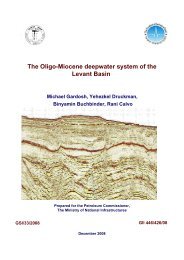tivity on the carmel faul
tivity on the carmel faul
tivity on the carmel faul
Create successful ePaper yourself
Turn your PDF publications into a flip-book with our unique Google optimized e-Paper software.
caused by curved segments al<strong>on</strong>g <strong>the</strong> DST. Geophysical studies suggest that <strong>the</strong> crust,<br />
including <strong>the</strong> c<strong>on</strong>tinental shelf is divided into two, and that <strong>the</strong> CF system is <strong>the</strong> boundary<br />
between <strong>the</strong>m. The sou<strong>the</strong>rn part includes central Israel and <strong>the</strong> nor<strong>the</strong>rn part includes Galilee<br />
and Leban<strong>on</strong> (Garfunkel and Almagor, 1985; Ben-Avraham and Gintzburg, 1990; Hofstetter et<br />
al., 1991).<br />
The CF, which follows a general NW to SE directi<strong>on</strong> (Fig. 1), is a set of many small <strong>faul</strong>t<br />
strands and has distinct tect<strong>on</strong>ic and morphological expressi<strong>on</strong>s (Hofstetter et al., 1996). The<br />
<strong>faul</strong>t z<strong>on</strong>e is quite complex with a terrestrial uplifting of about 500m above sea level. The CF<br />
and its c<strong>on</strong>tinuati<strong>on</strong> as <strong>the</strong> Gilboa Fault (GF) toge<strong>the</strong>r combine to create a seismically active<br />
z<strong>on</strong>e stretching for approximately 130km (Fig. 2; Hofstetter et al., 1996). Given that <strong>the</strong><br />
seismic ac<str<strong>on</strong>g>tivity</str<strong>on</strong>g> in <strong>the</strong> Galilee coastal plain is c<strong>on</strong>nected to <strong>the</strong> c<strong>on</strong>tinuati<strong>on</strong> of <strong>the</strong> <strong>faul</strong>t in <strong>the</strong><br />
Mediterranean (R<strong>on</strong> et al., 1984; Achm<strong>on</strong>, 1986; Ben-Gai, 1989), <strong>the</strong> <strong>faul</strong>t z<strong>on</strong>e stretches more<br />
than 170km. Rotstein et al. (1993) carried out a series of high resoluti<strong>on</strong> seismic lines crossing<br />
<strong>the</strong> CF z<strong>on</strong>e, which permitted a detailed analysis of its shallow structure and nature. According<br />
to <strong>the</strong>ir analysis <strong>the</strong> CF is a wide z<strong>on</strong>e of intense deformati<strong>on</strong> ra<strong>the</strong>r than a single <strong>faul</strong>t trace. In<br />
<strong>the</strong> Jezreel Valley <strong>the</strong> deformati<strong>on</strong> is limited to an approximately 800m wide z<strong>on</strong>e and appears<br />
to be associated with pure strike-slip moti<strong>on</strong>. East of Mt. Carmel <strong>the</strong> <strong>faul</strong>t changes trend from<br />
NW-SE to about N-S, and coincides with a z<strong>on</strong>e of intense deformati<strong>on</strong> at least 3km wide.<br />
North of Mt. Carmel, where <strong>the</strong> <strong>faul</strong>t resumes its NW-SE trend, it is nearly vertical at depth.<br />
The development of movement al<strong>on</strong>g <strong>the</strong> CF system with time has been addressed by<br />
different studies. Ben-Avraham and Gintzburg (1990) suggested that <strong>the</strong> CF originates in a<br />
Paleozoic suture line between accreted terrains, which <strong>the</strong>y linked to <strong>the</strong> closure of <strong>the</strong> Paleo-<br />
Tethys. Achm<strong>on</strong> and Ben-Avraham (1997) suggested three major stages of tect<strong>on</strong>ic<br />
development: A Triassic-Jurassic rifting phase due to a N-S opening of <strong>the</strong> Neo-Tethys. A<br />
compressive phase of <strong>the</strong> Late Miocene, which <strong>the</strong>y suggest causes left lateral strike-slip<br />
movement al<strong>on</strong>g <strong>the</strong> CF z<strong>on</strong>e, where some of <strong>the</strong> older <strong>faul</strong>ts are reactivated. An uplifting<br />
phase during <strong>the</strong> Pliocene-Pleistocene, in which most of <strong>the</strong> <strong>faul</strong>ts are reactivated as normal<br />
<strong>faul</strong>ts, and <strong>the</strong> regi<strong>on</strong> of <strong>the</strong> Carmel, Umm-El-Fahm and <strong>the</strong> Gilboa are raised and tilted to <strong>the</strong><br />
southwest. The extent of <strong>the</strong> uplifting movement of Mt. Carmel during <strong>the</strong> Pliocene-<br />
Pleistocene to <strong>the</strong> present has not yet been clearly resolved.<br />
The Carmel regi<strong>on</strong> is an isolated mountain range in northwestern Israel (Fig. 1). Upper<br />
Cretaceous marine rocks are exposed (Kashai, 1966; Karcz, 1958) al<strong>on</strong>g with volcanic<br />
intercalati<strong>on</strong>s (Sass, 1980) and marine Paleogene rocks (Karcz, 1958). The stratigraphic<br />
sequence shows limest<strong>on</strong>es, dolomites, chalk and marls (Sass, 1957; Karcz, 1958; Kashai,<br />
17

















